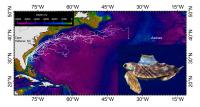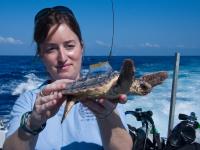
This shows the North Atlantic tracking routes of 17 juvenile loggerhead sea turtles. A new study satellite tracked 17 young loggerhead turtles in the Atlantic Ocean to better understand sea turtle nursery grounds and early habitat use during the 'lost years.' The study, conducted by a collaborative research team, including scientists from the University of Miami (UM) Rosenstiel School of Marine and Atmospheric Science, was the first long-term satellite tracking study of young turtles at sea.
"This is the first time we were able to show the maiden voyage of young turtles after they left the beach," said Rosenstiel School scientist Jiangang Luo and co-author of the study. "It's like you want to know how your baby is doing when you drop him or her off at the daycare for the first time."
The turtles' at-sea movements were remotely tracked for 27-220 days in the open ocean to better understand their movements, habitat preferences and thermal niche during this early-life stage. The turtles traveled between 200 km to 4300 km (124 - 2672 miles), mainly traveling off of the continental shelf region and occupying oceanic surface waters, where young turtles likely "receive thermal benefits from solar absorption," according to the study's authors. The study also showed that young sea turtles rarely travel into continental shelf waters and frequently leave the currents of the Gulf Stream and North Atlantic Current within the North Atlantic Subtropical Gyre.
The turtle started by riding in the strongest currents in the Ocean, the Gulf Stream, then, the North Atlantic Current. But many of the turtles took a short cut via eddies which span off from the currents to the Sargassum Sea at the center of the North Atlantic Subtropical Gyre, which provide protection, thermal and food habitat for the young turtles. 
This shows a baby loggerhead sea turtle outfitted for release.
The 17 loggerhead turtles were collected from nests along the southeast coast of Florida and reared in Florida Atlantic University's turtle laboratory before being released between 3-9 months of age into the Gulf Stream, offshore of their natal beaches. Prior to being released, solar-powered satellite tags were affixed to the turtles' carapace.
"What is exciting is that we provide the first look at the early behavior and movements of young sea turtles in the wild," said University of Central Florida biologist and Rosenstiel School alumna Kate Mansfield, who led the team. "Before this study, most of the scientific information about the early life history of sea turtles was inferred through genetics studies, opportunistic sightings offshore, or laboratory-based studies. With real observations of turtles in their natural environment, we are able to examine and reevaluate existing hypotheses about the turtles' early life history. This knowledge may help managers provide better protection for these threatened and endangered species."
Once young turtles leave their nesting beaches they spend an unknown number of years at sea. Called the sea turtles 'lost years,' little is known about the migration and habitat use of young sea turtles during this period before they return to near-shore habitats as larger juveniles.
Source : dudel@rsmas.miami.edu
 Print Article
Print Article Mail to a Friend
Mail to a Friend
